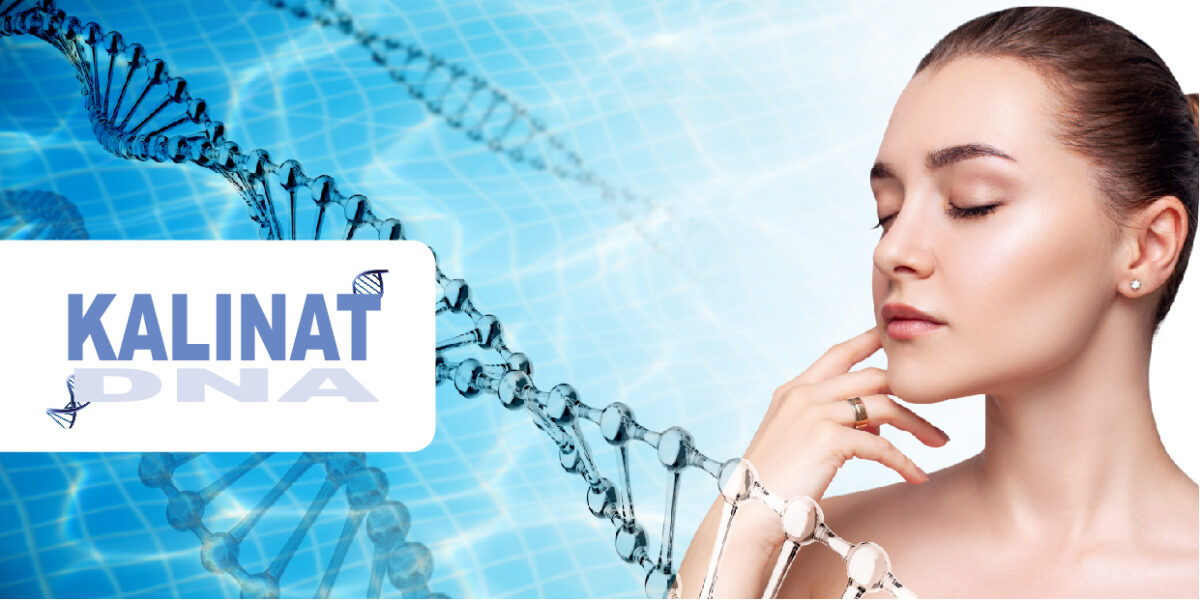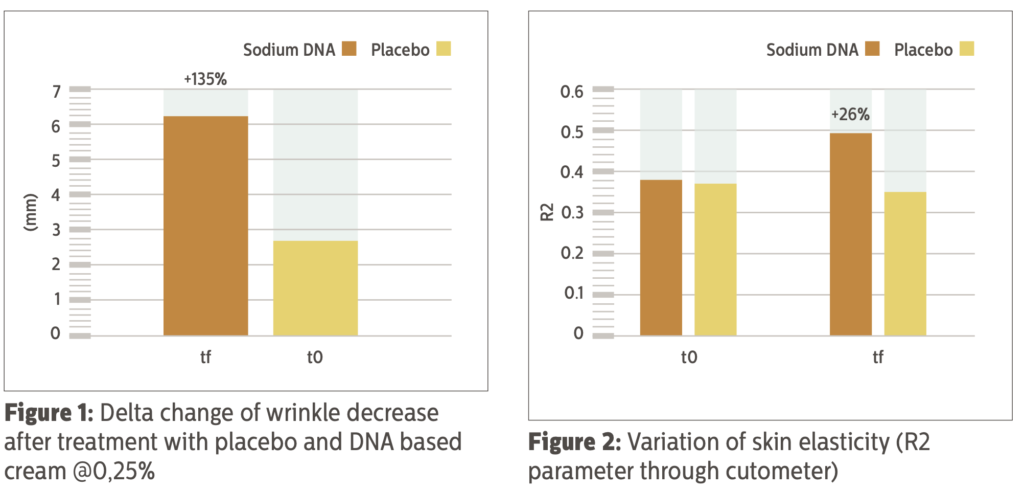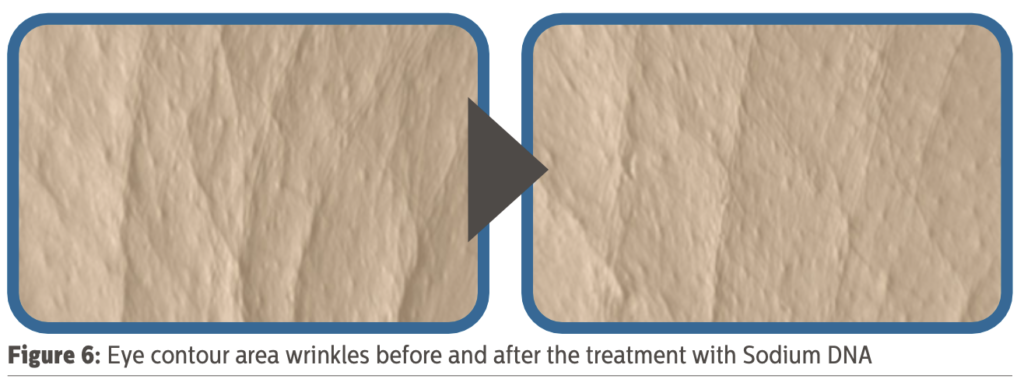KALINAT DNA: Upcycled anti-wrinkle and skin repair active from molecular biology
DNA: the molecule of life, with anti-wrinkle activity and promoting cell proliferation.

19 July 2022
Skin ageing is a physiological and unavoidable process due to intrinsic and extrinsic factors.
Intrinsic factors are genetic, hormonal and pathological. Extrinsic factors are external causes such as exposure to UV rays and pollution, smoking, and poor lifestyle and nutrition habits. Skin changes are therefore inevitable.
There are intrinsic factors responsible for paler, drier, less elastic skin with fine and deep wrinkles. This is because of tissue modification with a reduction of dermal mast-cells, fibroblasts, collagen production, flattening of dermal-epidermal junction and rete ridges. A decrease in skin turgor, meanwhile, is due to reduction in skin hydration, while a reduced number of keratinocytes and an unbalanced hydrolipidic film on the surface cause a reduction of epidermis function.
A drop of nutrient support to the epidermis, due to a loss of the rete ridges and their reciprocal inter-digitation with capillary-rich dermal papillae, involves a flattening of the undulating epidermis. Cell damage because of mutations during metabolic processes brings out free radicals. Moreover, during the menopause, elastin fibre atrophy leads to the formation of a thinner dermis and reduced skin elasticity.
On the other hand, skin is a daily target of the extrinsic factors result in coarse wrinkling, rough texture, sallow complexion with mottled pigmentation and loss of skin elasticity.Skin ageing is therefore a physiological and inevitable process, and an action on different levels is necessary to slow down and alleviate it. Active ingredients with multiple biological targets including immune system modulation, repairing and regenerating activities on epidermis and dermis represent relevant candidates to counteract the onset of skin ageing.
Sodium DNA: ageing remedy from upcycling sourcing
The object of this discussion is the description of a pure sodium DNA powder (tradename: Kalinat AW Powder, INCI name: Sodium DNA, manufactured by Kalichem), used for anti- wrinkle, skin lifting and regeneration purposes.
Sodium DNA is a polymer made of polydeoxyribonucleotides (PDRNs) with partially preserved double helix structure and a molecular weight ranging from 250-500 kDa, coming in form of hydro-soluble and odourless white powder. The complex process of molecular biology to obtain it derives from an exclusive GMP-inspired method based on DNA extraction from upcycled marine sources and food waste, in accordance with the forever growing trend of research of sustainable and environment friendly solutions in the industry.
Upcycling and circular economy

The sourcing of raw materials through upcycling and circular economy is a fast-growing trend in all industries, including personal care. The target of the industry is to drive consumers toward the use of substances meeting the requirements imposed by social, economic and environmental sustainability standards. The selection of cosmetics is no longer to be intended as a simple act of purchasing products, but as a ‘sharing ideals’process.
Following this concept, the cosmetics market is therefore looking for specialties sourced through circular economy processes, and more specifically technologies enabling the use food industry byproducts, otherwise wasted and potentially polluting given the necessary operations of disposal.
In particular, food waste is associated with greenhouse gas emissions of approximately 3.3 billion tons of carbon dioxide (CO2), equal to over 7% of total emissions (in 2016, equal to 51.9 billion tons of CO2). In 2013, the Food & Agriculture Organization of the United Nations (FAO) concluded that, if food waste were a nation, it would be the third highest emitter of greenhouse gases in the world, behind China and the United States.
Food waste is therefore one of the major causes of the ecological crisis, due to the alteration of geological, biological and physical processes, including the cycle of carbon, water, nitrogen and phosphorus. In such a context, the cosmetics industry can give a relevant contribution through a responsible and ethical sourcing of the ingredients used in mass consumption products like anti-ageing cosmetics. An active ingredient like Sodium DNA supports this dynamic, given its sourcing from upcycled food waste of marine origin.
Sodium DNA: scientific background
In the past years, many in vitro, in vivo and clinical studies were performed to demonstrate the main functions of sodium DNA on the skin. The anti-ageing, wound healing and anti-inflammatory properties of Sodium DNA are likely mediated by the activation of A2A adenosine receptors, which stimulate fibroblast proliferation and consequently induce collagen and dermal matrix components synthesis.
The tropism for the A2A adenosine receptor is suggested by in vitro assessments on human fibroblasts, where the effect of adenosine and sodium DNA was proven to be reduced through the use of an antagonist of the A2A receptor, the 3.7-Dimethyl-1- propargylxanthine (DMPX).
Recent studies suggest additional mechanisms of action and biological targets linked to immune system modulation activity,5 including the activation of Toll Like Receptor-9 (TLR-9), typically expressed in macrophages (ubiquitous immune cells found on the skin, with a key function in skin repair) and dendritic cells. The targeting of these specific receptors is assumed to be promoted by its peculiar composition made of at least 50% of Cytosine and Guanidine pairs.
The interaction between DNA and TLR-9 receptors triggers the formation of growth factors including mainly the transforming growth factor beta (TGF-β) stimulating fibrogenesis processes, dermal matrix components biosynthesis and the modulation of the vascular endothelial cell growth factor (VEGF) expression.
Furthermore, scientific evidence highlights the key role of DNA in reducing the formation of cyclo-butane pyrimidine dimers (CPDs),8 namely physiological skin cells nucleic acid alterations (derived from excessive exposure to UV rays), that may trigger cancerogenic and mutagenic events leading to skin melanoma.
In vitro tests demonstrate the capability of Sodium DNA to reduce by 60% the content of CPDs after six hours. This action is promoted by the concurrent modulation of the production of a surveillance protein of the immune system, the p53 protein, whose expression is increased by 62% compared to control treatments within 24 hours after UV exposure.
Additional studies demonstrate increased proliferation of skin fibroblasts,4,9,10 as well as increase of mature stem cells proliferation induced by the Sodium DNA.
Sodium DNA is currently used in the pharmaceutical field for inflammation diseases, re-epithelizing treatments, wound healing, as well as in aesthetic medicine, specifically in injectable fillers for anti- ageing purposes. South Korean aesthetic medicine industry has shown growing interest in using sodium DNA fillers in regenerative dermatology and mesotherapy treatments,
to obtain an anti-ageing action promoted by the repair and renew of cells with the aim of achieving a younger-looking skin.
The highly objectified safety profile of Sodium DNA proven in all the current applications fields where it is used, implied its worldwide approval in cosmetics industry and its inclusion in all international database and inventories, including Australia, Canada, China, the EU etc.
Sodium DNA: description of its activity and interaction with the skin

The activity of Sodium DNA on the skin epidermis after cosmetics application is determined by multi-level interactions.
At first, when it is applied on the skin surface, its double helix supercoiled tridimensional configuration and its bio-polymeric nature (made of 400-750 base pairs) create a bio- compatible film on the epidermis and promote a peculiar tensor effect determined by the anchor points that it establishes with the cutis thanks
to its large surface of contact: this interaction lifts mechanically the epidermis through an immediately perceivable horizontal pull that mimics aesthetic-treatment liftings.
From a biological standpoint, the sodium DNA interacts with immune cells found on skin surface promoting fibrogenesis through TLR-9 receptors activation and reducing the damages induced by excessive exposure to UV-rays.
It could be internalized through either pinocytosis,14 trans-appendageal route (eg. diffusion via hair follicles or sweat glands)
or trans-epidermal route (e.g. in presence of loosening of the tight junction involved in the skin barrier correct functioning, for instance after excessive use of aggressive surfactants, prolonged UV exposure or in pathological/open wounds conditions) and consequently interact with dermal fibroblasts A2A receptor, stimulating their proliferation together with the previously described actions.
In light of the above studies and mechanisms, not only has sodium DNA become an ideal candidate for applications linked to skin anti- ageing and aged skin repair, it also represents an innovative solution for photo-ageing, UV-damage repair, wound healing and rosacea applications.
Sodium DNA: in vivo and in vitro tests
A double-blind study was performed to investigate the efficacy of an emulsion containing 0.25% of Kalinat AW Powder Sodium DNA in reducing wrinkles, promoting skin elasticity and thickness increase. The control was a placebo emulsion.
Twenty volunteers participated, with a panel including Caucasian females aged from 30 to 60 with an average age of 49.
The product was applied on the periocular area on both eyes twice a day for eight weeks. The in vivo tests were coupled to in vitro evaluations on fibroblast proliferation (through MTT to ass cell viability) and inhibition of the elastase, enzyme degrading the skin elastin (through spectrophotometry).
In order to evaluate the in vivo results on the skin, various instruments were used before and during the application:
■ A cutometer for the elasticity. The probe makes a pressure, a cycling suction, and the level of skin deformation is measured with electrical means.
■ Skin imprints made by quick-hardening resin and an analysis of images of skin replicas for the reduction of skin wrinkles.
■ Scanning software and ultrasound scanner at high resolution with high frequency (30 MHz) ultrasound emission for thickness. This instrument makes a scan of the skin until 3 cm of depth, with an axial resolution of 50 μm and a lateral resolution of 350 μm.
■ A corneometer used for moisturization level. The results were indicated in corneometric unit. Its probe in contact with the skin registers the conductance based on the hydration level of the external stratum.
The only two requests during the test period were to not use other type of emulsions and to not exposure to sunlight for prolonged period. The results of the test showed a delta decrease of wrinkle depth induced by the Sodium DNA treatment superior by 135% in comparison to the value observed with the placebo treatment (Figure 1),
As for the skin elasticity and thickness, the area treated with Sodium DNA showed a significant increase of the R2 parameter by 26% when comparing the values of elasticity between time 0 and the end of the treatment (Figure 2).

Together with a thickness delta increase induced by sodium DNA 3 folds higher (+300%) than placebo, with a recorded +10% increase observed at the end of the treatment (Figure 3).
The value of increased elasticity and thickness recorded in vivo finds correspondence with in vitro scientific evidence of the high affinity interaction of sodium DNA with A2A fibroblast receptor. The evidence of such interaction is supported by its proven dose-dependent induction of fibroblast proliferation (Figure 4). Sodium DNA also induces keratinocyte expression increase (data not shown) and an inhibitory activity of 34.61% recorded on elastases, which are enzymes responsible of the degradation of skin elastin, a key component of the dermal framework (Figure 5).

The result of the treatment determined a significant and tangibly visible activity (Figure 6) observed in the peri-ocular area (an area typically challenging to target given its lower local micro-circulation, the multitude of face mimic muscle and the complex dermal framework surrounding it), with a reduction of deep wrinkles and evening of finer lines. The skin moisturization recorded at the corneometer showed significant variation of 5% of moist increase following the treatment with Sodium DNA.

Kalinat DNA: exclusive biotech active ingredient
Kalinat AW Powder is an exclusive biotech active ingredient based on pure Sodium DNA. Its polydeoxyribonucleotides show a preserved double helix structure, and they are obtained through an advanced bio-technological extraction starting from sources derived from circular economy and food waste upcycling.
From a functional standpoint, it represents an ideal solution for personal care industry to counteract multiple ageing factors thanks to its modulating action on skin immune system, its stimulatory action on the various cutaneous cell types, its regenerating action on damaged epidermal and dermal structures and preventive action against the effects of photo-ageing.
Its polymeric structure promotes a ‘consumer friendly’ and immediate skin lifting effect linked to its peculiar tridimensional supercoiled structure, while its typical polydeoxyribonucleotides composition interacts both with immune cells (macrophages and dendritic cells) and fibroblasts to determine the stimulation of the fibrogenesis, collagen and dermal extracellular matrix components synthesis together with a proven inhibition of the degradation of elastin fibres.
In vivo tests prove its significant wrinkle reduction, skin elasticity and thickness increase while in vitro assessments confirm its suitability
Figure 4: 24h MTT test carried out comparing Sodium DNA versus non-treated control for treatments addressed to counteracting the harmful effects of massive UV-exposure, promoting skin damage and wound repair, and supporting the restoring of homeostasis in skin subject to alterations of the local micro- circulation.
In line with the trends of ‘clean and clinical beauty’ and the choice of specialties with low environmental impact in accordance with modern sustainability standard requirements, sodium DNA represents a smart and innovative solution for skin care applications like anti- ageing, anti-wrinkle, skin lifting, re-epithelizing treatments following skin wounds (related to skin burn, acne, stretchmarks, excessive dryness etc.), prevention of photo-ageing and skin microcirculation balancing.
Ingredients
Formulations
Wrinkle Lift Cream
Cream containing a unique combination of postbiotics, DNA active, with advanced anti wrinkle and lifting features.
Anti-Wrinkle Serum
Serum based on Sodium DNA (KALINAT AW POWDER), based on polydeoxyribonucleotides with anti-wrinkle, elasticity enhancing and regenerative action.
Anti-Ageing Face Cream
Day cream with silicon like luxury texture and immediate tensor effect. Containing a patented olive and oat based emulsifier and DNA.











